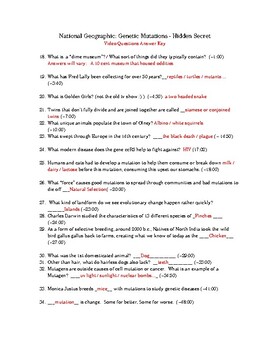Genetic Mutations Nat Geo Genetic Mutations - Hidden Secret Movie Questions
WilsonScience
5 Followers
Grade Levels
7th - 10th
Subjects
Resource Type
Standards
NGSSMS-LS1-5
NGSSMS-LS3-1
NGSSMS-LS3-2
NGSSMS-LS4-2
Formats Included
- PDF
Pages
2 pages
WilsonScience
5 Followers
What educators are saying
Great resource to use and my students enjoyed it. It was easy to use and helpful to obtain clarification of the concept. Helpful to use with all my students.
Such a great time saver. While I like to make my own resources, it is great when you can find one that is done well.
Description
Great for an Emergency sub plan! The documentary by National Geographic,
(Genetic Mutations - Hidden Secret) is relative to the 8th grade genetics unit, its engaging and its on YouTube. https://www.youtube.com/watch?v=Kk2yHeRoc9w
Its also 48 minutes long which is perfect for a 55 minute class period. The questions are in order and they're time stamped so you know when the answers are coming up.
Answer key included
Total Pages
2 pages
Answer Key
Included
Teaching Duration
55 minutes
Last updated Sep 27th, 2019
Report this resource to TPT
Reported resources will be reviewed by our team. Report this resource to let us know if this resource violates TPT’s content guidelines.
Standards
to see state-specific standards (only available in the US).
NGSSMS-LS1-5
Construct a scientific explanation based on evidence for how environmental and genetic factors influence the growth of organisms. Examples of local environmental conditions could include availability of food, light, space, and water. Examples of genetic factors could include large breed cattle and species of grass affecting growth of organisms. Examples of evidence could include drought decreasing plant growth, fertilizer increasing plant growth, different varieties of plant seeds growing at different rates in different conditions, and fish growing larger in large ponds than they do in small ponds. Assessment does not include genetic mechanisms, gene regulation, or biochemical processes.
NGSSMS-LS3-1
Develop and use a model to describe why structural changes to genes (mutations) located on chromosomes may affect proteins and may result in harmful, beneficial, or neutral effects to the structure and function of the organism. Emphasis is on conceptual understanding that changes in genetic material may result in making different proteins. Assessment does not include specific changes at the molecular level, mechanisms for protein synthesis, or specific types of mutations.
NGSSMS-LS3-2
Develop and use a model to describe why asexual reproduction results in offspring with identical genetic information and sexual reproduction results in offspring with genetic variation. Emphasis is on using models such as Punnett squares, diagrams, and simulations to describe the cause and effect relationship of gene transmission from parent(s) to offspring and resulting genetic variation.
NGSSMS-LS4-2
Apply scientific ideas to construct an explanation for the anatomical similarities and differences among modern organisms and between modern and fossil organisms to infer evolutionary relationships. Emphasis is on explanations of the evolutionary relationships among organisms in terms of similarity or differences of the gross appearance of anatomical structures.



